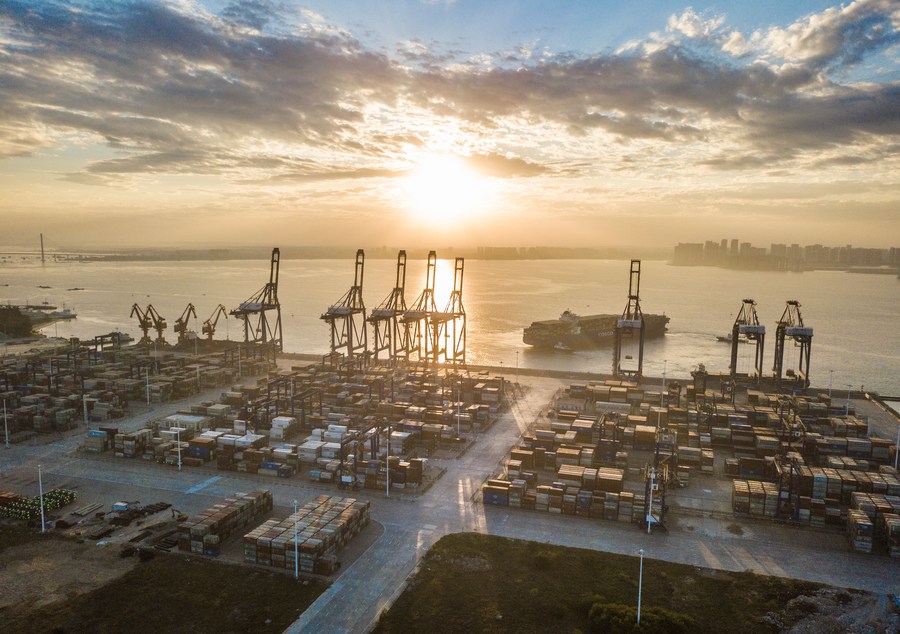Economic resilience matters in a world of uncertainties, see how China gets it

Aerial photo taken on Dec. 5, 2021 shows the sunrise scenery of the Yangpu international container port at Yangpu economic development zone in south China's Hainan Province. (Xinhua/Pu Xiaoxu)
BEIJING, Feb. 1 (Xinhua) -- Tracing the trajectory of economic recovery worldwide, people will find that China's resilience is an indisputable force. But how exactly has the Chinese economy built its tenacity in an environment of mounting challenges?
Securing an 8.1 percent year-on-year expansion in 2021, China maintained its position as the locomotive of the world's economic recovery, with Chinese products from vaccines to Christmas lights shipped across the world, domestic consumption maintaining steady growth, and promising sectors such as the photovoltaic industry and new energy vehicles (NEVs) booming.
Analysts believe that China's economic tenacity is largely a result of its socialist market economy, its continuous efforts to open up, as well as macroeconomic policies that are targeted, efficient and sustainable, and the roles of its complete industrial chain, vibrant market entities and super-sized domestic market.
"VISIBLE HAND" AND "INVISIBLE HAND"
One of the sources of China's economic resilience is its ability to properly handle the relationship between the government, "the visible hand," and the market, "the invisible hand" -- a delicate balancing act facing policymakers globally.
What makes the socialist market economy with Chinese characteristics stand out is its combination of the roles of an effective market and a well-functioning government.
In one example of this synergy, the Chinese government last year improved a market-oriented pricing mechanism for coal-fired power to address power shortages while accelerating the release of its coal production capacity, advancing government reserves of coal and curbing price gouging in the coal market.
Over the past few years, China has made properly handling the relationship between the government and the market a core part of the reforms to its economic system, underlining that the market should play a decisive role in allocating resources and the government should play its role better.
The Chinese government has constantly promoted a level playing ground for all market players and improved services for enterprises while lowering market access requirements and streamlining administrative procedures. This is another example of the concerted efforts of China's government and market.
SKILLFUL MACRO POLICIES
Facing the economic fallout from the COVID-19 pandemic, the Chinese government has enhanced macro adjustment, effectively shoring up the country's economic resilience.
After the pandemic sent the global economy spiraling toward its worst recession since World War II, some developed economies resorted to ultra-loose monetary policies to spur recovery, resulting in skyrocketing prices and, in some countries, the highest inflation rates in decades.
China, on the other hand, has adhered to a prudent monetary policy based on its reality, maintaining market liquidity at a reasonable level and keeping inflation under control.
China refrained from implementing a deluge of stimulus policies but rather implemented targeted preferential policies such as loan repayment deferrals and credit support for micro, small and medium-sized enterprises, said Xu Hongcai, deputy director of the Economic Policy Commission under the China Association of Policy Science.
"These moves played a critical role in relieving the strain on the real economy," Xu said.
"Economists see China as a conduit rather than a source of inflationary pressure," reported The Wall Street Journal last July.
Many Chinese factories absorbed higher costs for raw materials like copper and iron ore themselves, helping prevent consumer goods prices from rising even higher elsewhere, the newspaper said, citing the views of economists.
INDUSTRIAL CHAIN & CONSUMER STRENGTH
Adding to China's resilience against external shocks, the country boasts a complete industrial chain system, over 150 million market entities, a super-sized domestic market of over 1.4 billion people, and a middle-income population of over 400 million.
Official data shows that China's total trade in goods moved up another notch in 2021, exceeding 6 trillion U.S. dollars for the first time, despite the pandemic continuing to weigh on global trade.
Xu attributed the stellar performance of exports to China's expansive and strong supply chain, which adapted quickly to market changes as the resumption of production was halted or disrupted in many other countries due to COVID-19 resurgences.
The one-of-a-kind industrial chain enabled China to overcome the global shortages of shipping containers and chips. In 2021, the outputs of integrated circuits, metal shipping containers and NEVs grew by 33.3 percent, 110.6 percent and 145.6 percent, respectively.
A mega domestic market has also helped sustain China's economic resilience. The country's retail sales topped 44 trillion yuan (about 6.9 trillion U.S. dollars) in 2021 and drove up 65.4 percent of economic growth.
STAYING OPEN
While politicians in certain countries have preached a "decoupling" and protectionism in a world still reeling from the pandemic, China has remained firm in propelling globalization, building a community with a shared future for mankind, and safeguarding true multilateralism.
In 2021, China filed applications to join the Comprehensive and Progressive Agreement for Trans-Pacific Partnership and the Digital Economy Partnership Agreement. The Regional Comprehensive Economic Partnership pact, the world's largest trade deal, signed by 15 Asia-Pacific countries including China, entered into force in January 2022.
Easier access to an ever-growing market drew foreign investment, which in turn increased the vitality and resilience of the economy.
Foreign direct investment into the Chinese mainland, in actual use, hit a record high when it expanded 14.9 percent year on year to 1.15 trillion yuan in 2021.
Nicolas Vix, president of Credit Agricole CIB (China) Ltd., described China as of "primary importance" to the bank's development.
A wholly owned subsidiary of France's Credit Agricole Corporate and Investment Bank, Credit Agricole CIB (China) has enjoyed booming development in the Chinese market over the past decades and aims to continue its double-digit growth in the Chinese market this year.
Speaking of the country's economic resilience, Vix said that "China has built an industrial base second to no other country in the world" and has the ability to make constant improvements and fend off challenges encountered over past decades, as seen in the country's handling of the COVID-19 pandemic.
Looking ahead, Vix said he expects new opportunities to sprout from China's sustainable development and continued opening-up.
Photos
Related Stories
- "All people are my brothers and sisters"
- China's fixed-asset transport investment tops 3 trln yuan in first 11 months
- China's stock market draws 1.34 mln new investors in November
- People enjoy outdoor winter sports in N China
- China launches new resource satellite
- Yearender: The A to Z of China-ASEAN relationship
- China ranks 2nd as home to over 300 unicorn companies: report
- China's 2022 national entrance exams for postgraduate studies kick off
- Report: Biz operations will stay strong
- China association opposes U.S. suppression on Chinese cotton industry
- Economic Watch: China's manufacturing PMI in expansion zone as recovery sustains
- People's Daily: World trade faces downside risks
- Economic food for thought
- Key meeting stresses growth still the priority
- Economic sanctions on Syria threaten support for Assad
Copyright © 2022 People's Daily Online. All Rights Reserved.










